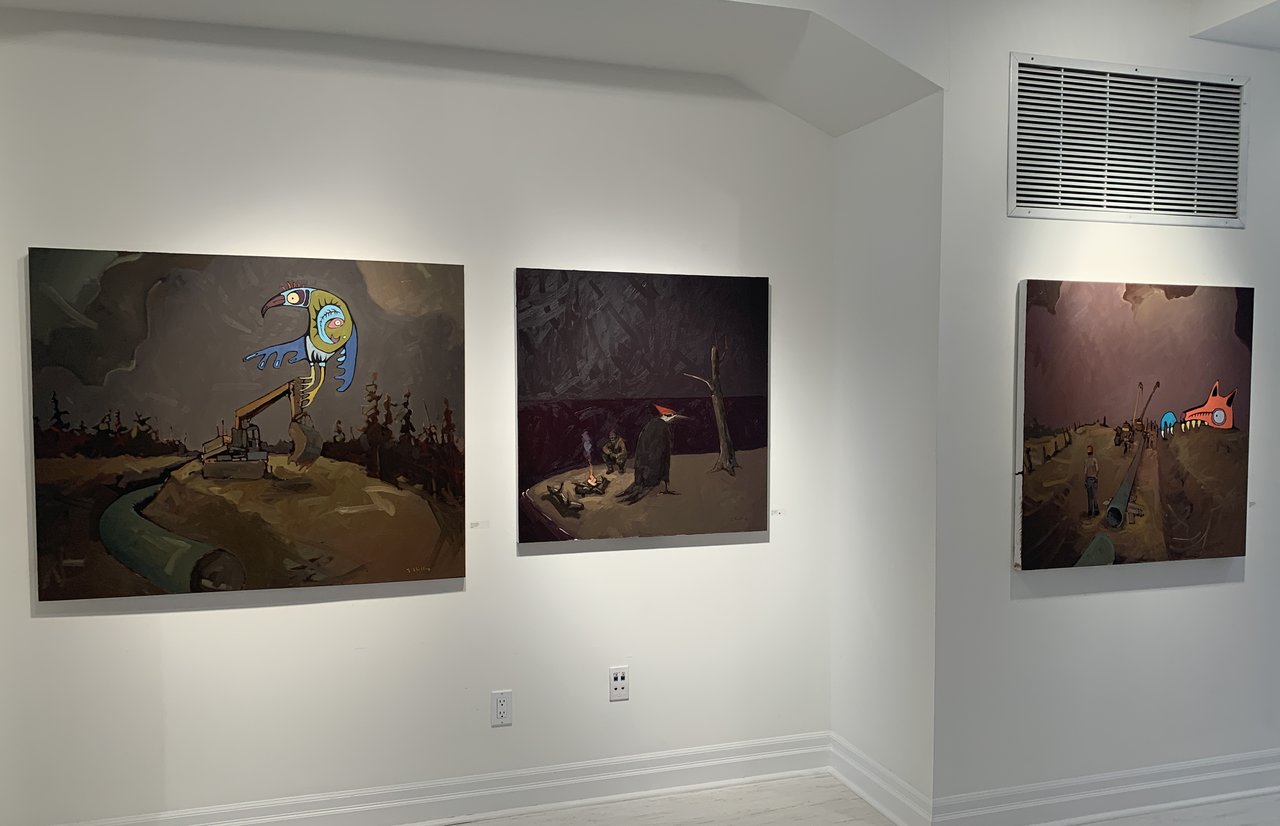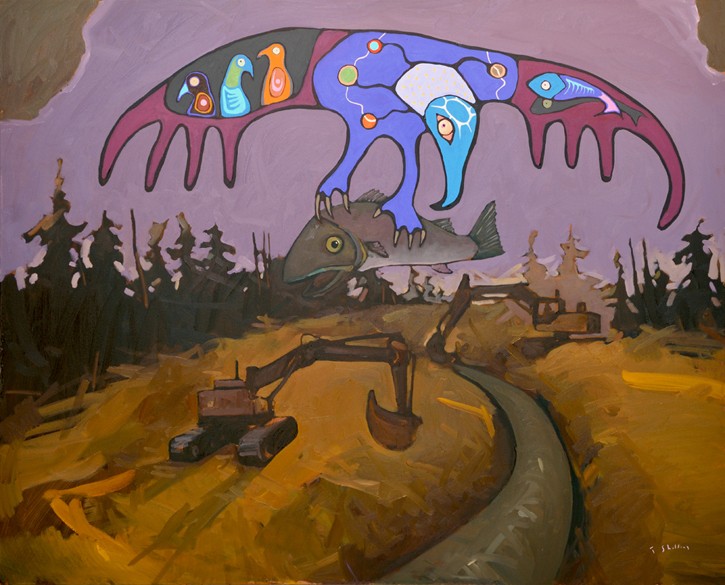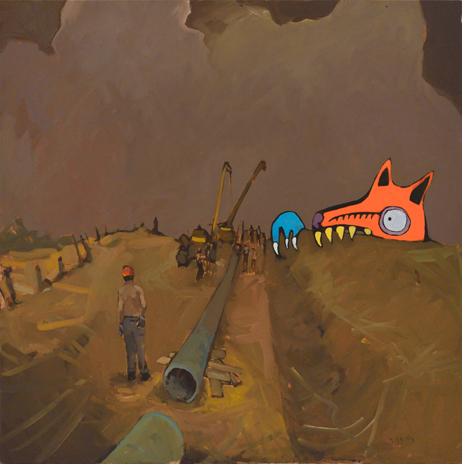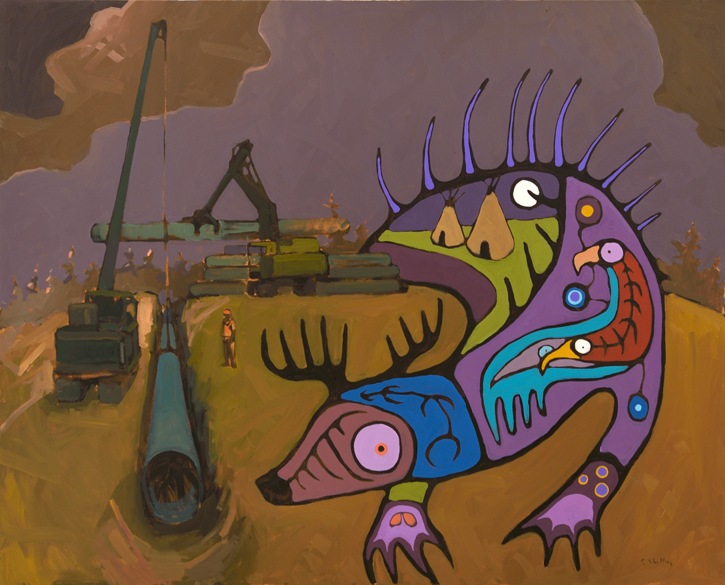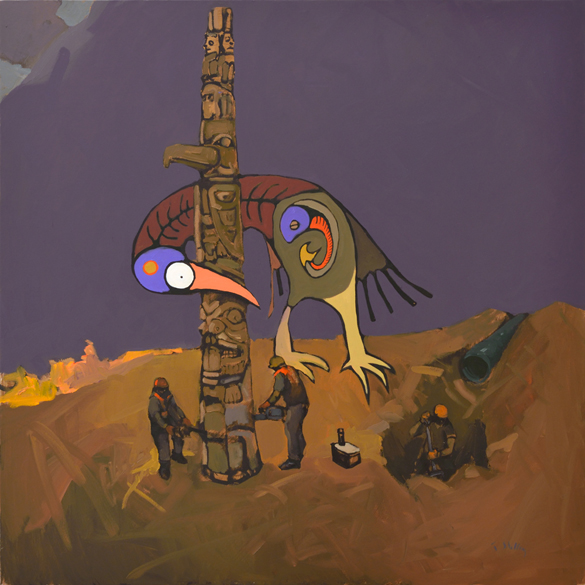Spirits look upon the Canadian landscape stripped of life in the process of constructing pipelines. As the spirits look on, humans carry on with their destruction, completely unaware of the otherworldly presences of spirits who cannot physically intervene.
Travis Shilling is an Indigenous Canadian artist from the Ojibway Nation and was born in Rama, Ontario. He is the son of Arthur Shilling who was also a well-known Indigenous artist. Travis Shilling’s strong colour palettes are reminiscent of his father’s style. According to the Gallery Director, Tarah Aylward, he has been influenced by the Group of Seven, as he was exposed to their work when he was quite young. Shilling’s work is also reminiscent of Norval Morriseau, another Indigenous Canadian artist, which can be seen in his rendering of the spirits in his paintings, but Shilling’s work cannot be reduced to just the influences of other painters. His artworks are entities that speak for themselves, pushing further than his influencing artists.
Installation view of Travis Shilling, Tyrannosaurus Clan, at Ingram Gallery. Photo: Olivia Musselwhite
The title of Travis Shilling’s show at Ingram Gallery, Tyrannosaurus Clan is the merging of two terms. According to Tarah Aylward, pipelines are meant to transport petroleum which has been termed humorously as ‘Dino-Juice’. It is the term ‘Dino-Juice’ that resulted in Shilling’s choosing of the widely known ‘Tyrannosaurus’ species in the exhibition title. ‘Clans’ are the traditional method of distinguishing the family relationships of people. In this joining of terms, the title suggests that the people of the modern world have become a new clan that relies on natural gas and pipelines to transport it.
While Travis Shilling’s oil paintings now suggest the charged political climate around the development of pipelines in Canada, that political message was not on the artist’s agenda when he painted them. They were meant solely to replicate the visual state of the landscape.
The Excavators #1, 2019, oil on canvas, 48 x 60 in. Courtesy of Ingram Gallery
Shilling merges two styles of painting on the same canvas. In The Excavator #2 (2019), the artist depicts sweeping landscapes that are rendered with realism and adds the spirit. In this dark, barren and muddy scene with only the remains of tree stumps, a mammal spirit climbs a mound of earth in the distance, as if it is coming from inside the land, with its claws and jaw clenching the soil. The spirit looks upon the humans, who are unaware of its presence, with a wide eye. Like all the others in Travis Shilling’s pieces, is pictured in animal form and is much larger than the humans and their machinery. It is presented as a layered composition with depictions of other creatures and scenery within their figures. The spirits are brightly painted, semi-abstract, and seemingly part of the landscape as much as otherworldly.
The Excavator #2, 2019, oil on canvas, 36 x 36 in. Courtesy of Ingram Gallery
The Village (2019) portrays another spirit that is coming from the horizon and over the land. Its path angles toward the front of the pipeline, seemingly intersecting with it. In the spirit’s belly, there is a green landscape under a full moon, embodying what has been lost in the land due to human construction. Heavy machinery sits atop the mud in order to dig trenches where colossal pipes are to be lowered into the ground. The workers are minuscule compared to the machinery that engulfs them. They go about their duties without sensing the spirit or giving any thought to the destruction of nature and what it might mean in their future.
The Village, 2019, oil on canvas, 48 x 60 in. Courtesy of Ingram Gallery
Shilling’s works are filled with subtle and impactful details. Totem (2019) shows us the land decimated by pipeline construction. A bird-like spirit tenderly wraps its neck around a lone Totem pole, caressing it in an attempt to save it from being cut down. Again, there is no connection between the humans with the chainsaws and the spirit. Its effort to save the Totem is futile.
Totem, 2019, oil on canvas, 48 x 48 in. Courtesy of Ingram Gallery
These realistic, yet otherworldly scenes, bring the opportunity of furthering our conversation on extremely relevant topics in Canada. Studying Travis Shilling’s work gives us a deeper understanding of what Canada really is, with its rich Indigenous past and related economic struggles. He makes us face a rather dark and empty landscape in a land that used to be green, beautiful and fertile. Sad spirits from the past, or the deepness of the Indigenous soul, seem to be trying to stop the destruction and save the land and its traditions.
Olivia Musselwhite
*Exhibition information: Tyrannosaurus Clan, February 22 – March 12, 2020, Ingram Gallery, 24 Hazelton Avenue, Toronto. Gallery hours: Tue – Sat 10 – 5 pm.

